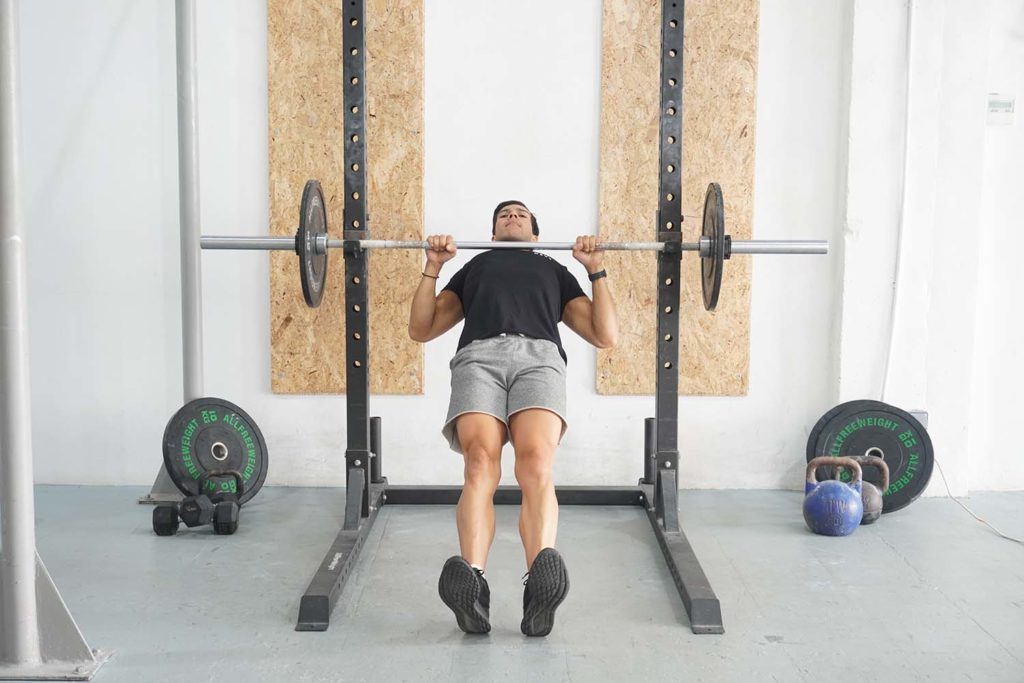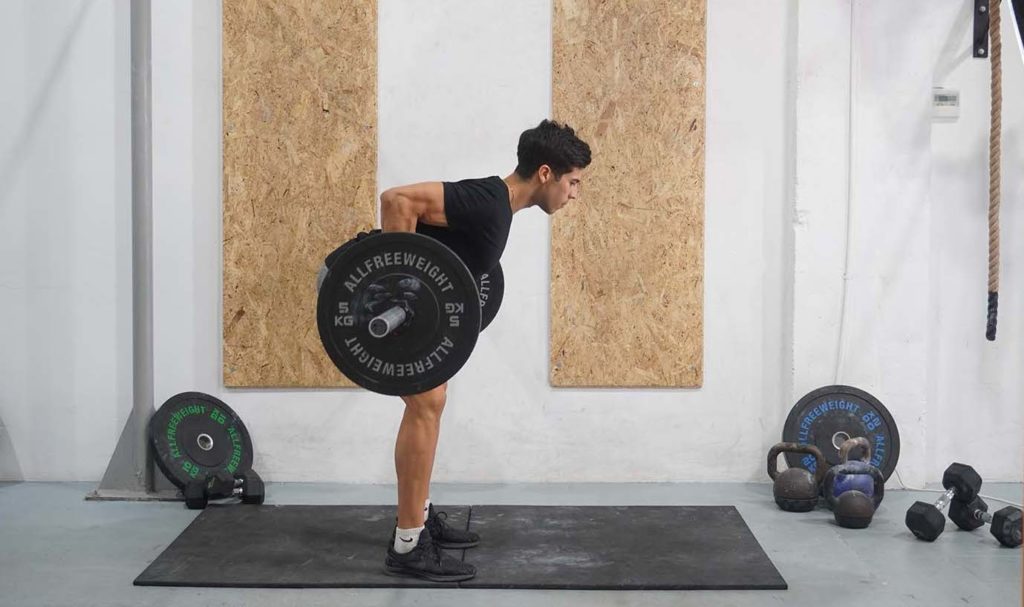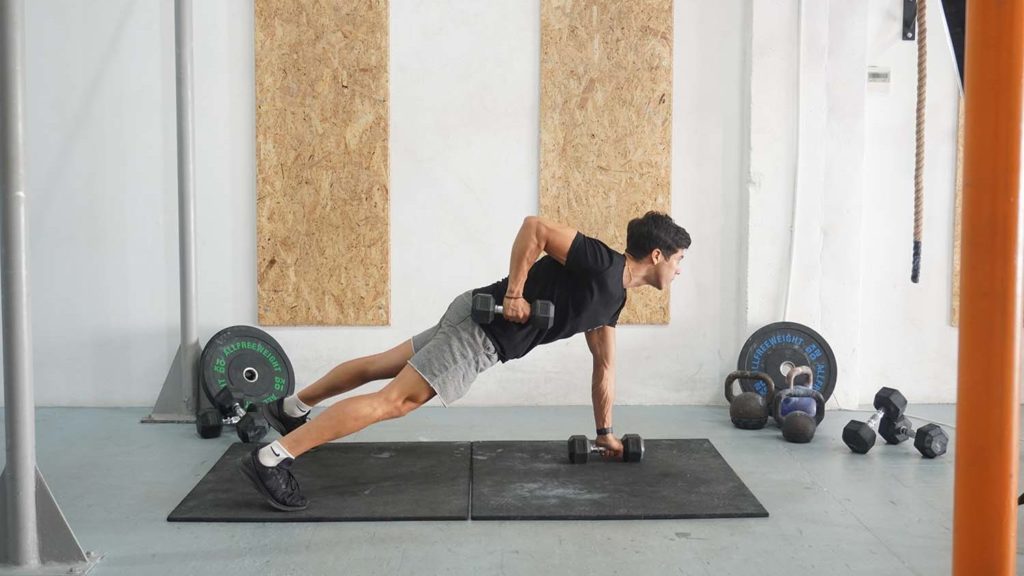Benefits of the Upright Row with a Barbell
Plenty of exercises train your back, just as many activities develop your shoulders. But no movement trains the two muscle groups like the upright row.
Despite its seeming simplicity, the upright row is a unique exercise that overloads your upper back, shoulders, and biceps with more weight. Plus, the movement is great because you can do it with various weights, perform it at home, and add it to a gym routine. The only consideration relates to shoulder safety. Some folks experience discomfort from the movement, so using a wider grip might be helpful.
As a back and shoulder exercise, the upright row improves posture, builds your pulling strength, and makes you more athletic. The movement also makes you better able to handle everyday tasks.
How to do a Dumbbell Upright Row
- Grab a barbell with an overhand grip at a shoulder-width level or slightly narrower.
- With the bar in your hands, stand tall, bring your chest out, direct your gaze forward, and position your feet about hip-width apart with toes pointed slightly out.
- Engage your abs, take a breath, and begin to row the barbell toward your chin by taking your elbows out and to the sides.
- Row the barbell to collarbone height, hold for a moment, exhale, and lower it to the starting position in a controlled manner.
- Take another breath and repeat the movement.
What muscles do an upright row with a barbell activate?
The primary muscle involved in the upright row is the trapezius (1). The muscle covers the upper back area and plays a vital role in shoulder health. Thanks to the upright row’s unique movement pattern, the trapezius is in an excellent position to produce much of the force we need to lift the weight.
Aside from the trapezius, other upper back muscles contribute to the upright row. Infraspinatus, rhomboids, erector spinae, and other muscles contract to keep our shoulders retracted and torso stable.
Deltoids (shoulders) are the second primary muscle in the upright row (1). Our shoulders play an essential role in arm abduction and shoulder flexion, so all three heads contribute to pulling the weight toward the chest (2).
Our biceps are also involved in the upright row. Their primary function is elbow flexion, which occurs as we lift the weight up (3). The midsection musculature (abs, transverse abdominis, and obliques) is engaged during the upright row, primarily to keep us rigid and in position.
The Difference Between an Upright Row and a Lateral Raise
At first glance, the upright row appears similar to lateral raises. Both movements train our shoulders and require us to lift our arms. But upon closer inspection, the two exercises are quite different and not at all interchangeable.
As discussed above, the upright row is a compound movement that allows you to overload your upper back, shoulders, and biceps with more weight. In contrast, lateral raises are an isolation exercise that primarily targets the shoulder (middle deltoid) (4). Upright rows also allow you to train with a barbell or EZ bar. In contrast, you must train each side individually during a lateral raise.
The upright row and lateral raise are fantastic exercises, and both have a place in any good training program. Upright rows allow you to use more weight, develop your pulling strength, and overload the often-overlooked deltoid. Similarly, lateral raises emphasize your deltoids, but you can’t use as much weight.
Variations and Modifications of the Upright Row with a Barbell
1. Snatch Grip Upright Row
The snatch grip upright row is a variation with a traditional barbell and a wide grip. Snatch upright rows are beneficial for emphasizing your traps and keeping your shoulders in a safer position.
2. Dumbbell Upright Row
Dumbbell upright rows are a nice variation you can start with as a beginner. Using dumbbells allows you to train both sides independently. Plus, there is less restriction, and you can row the dumbbells in a way that feels more comfortable.
3. Upright Row With a Pause
A common issue with upright rows is that many trainees turn the movement into an ego lift. A great way to prevent that from happening would be to force a brief pause at the top position. In doing so, you reduce the risk of using momentum and instead force your upper back, shoulders, and biceps to work extra hard in lifting the weight.
Mistakes to Avoid
The biggest mistake related to upright rows is the use of momentum, which typically results from trying to lift too much weight. Avoid the mistake by picking the appropriate load. As a rule of thumb, you should be able to do at least 8 to 10 smooth repetitions with a full range of motion.
Another significant mistake with upright rows is a narrow grip. Many trainees would have their hands close together as they row the weight, which increases the risk of shoulder impingement. A better way to go about the movement would be to use a shoulder-width grip.
The third significant mistake related to upright rows is lifting the weight too high. Doing so can stress your shoulders and increase the risk of an injury. Instead, lift the weight to chest level. As a rule of thumb, your elbows should never go higher than shoulder level.
Similar Exercises to the Upright Row with a Barbell
Inverted Row

The inverted row is a bodyweight back exercise. You must set up a bar at hip level or slightly higher––a Smith machine works well. Once set up, grab the bar, plant your feet on the floor, and straighten your body. A more vertical position makes the movement easier, whereas a horizontal torso makes it more challenging. From there, begin pulling yourself toward the bar. Tap the bar with your chest and lower your body by extending your elbows.
Barbell Row

The barbell row is a classic back exercise that builds your lats, rhomboids, trapezius, erector spinae, biceps, and forearms. You have to grab a barbell, bend forward, and pull the weight toward your stomach. Once the barbell taps your body, hold the contraction for a moment, and lower the weight by extending your elbows.
Renegade Row

Renegade rows are a more unusual exercise that has you assume a push-up position while holding onto a pair of hexagonal dumbbells. From the position, tilt your body slightly to one side, and begin rowing the dumbbell with your opposite arm. The movement works great because it forces your midsection to work extra hard, improving your stability.
